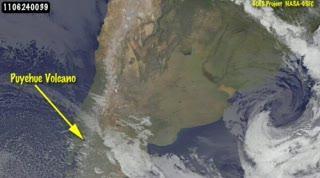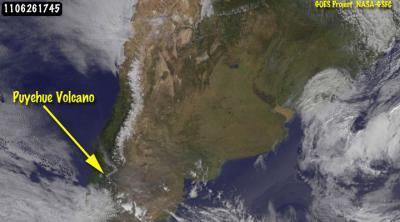Dennis Chesters of the NASA GOES Project noted of the animation, "The Chilean caldera still emits a steady stream of ash, three weeks after the initial eruption. Fortunately, the volume is much less, and the cold winter wind from the south carries it up the coast out over the Pacific, instead of over the Andes into Argentina."
According to CNN on June 28, the volcanic ash cloud was still affecting air travel in New Zealand, Australia. The eruptions of the Puyehue volcano, located in Puyehue National Park in the Andes of Ranco Province of Chile have also caused flight delays and cancellations in Argentina, Brazil, Chile and Uruguay.

This GOES-13 satellite imagery shows the Chilean caldera still emitting a steady stream of ash, three weeks after the initial eruption on June 4, 2011. The cold winter wind from the south carries it up the coast out over the Pacific, instead of over the Andes into Argentina. The video runs from June 24 through June 26, 2011.
(Photo Credit: (: NASA/NOAA GOES Project, Dennis Chesters))

This GOES-13 image from June 26 at 23:45 UTC (7:35 p.m. EDT) shows the light brown ash plume from the Puyehue-Cordón volcano blowing north.
(Photo Credit: (: NASA/NOAA GOES Project, Dennis Chesters))
Source: NASA/Goddard Space Flight Center